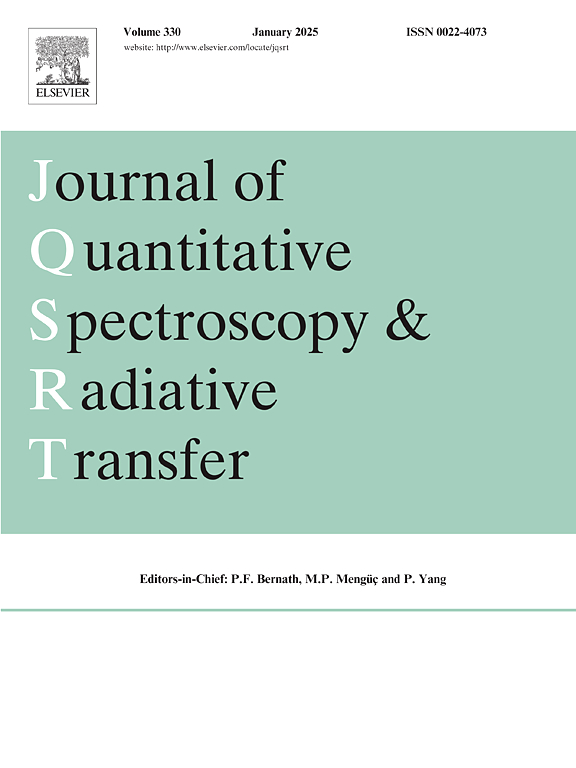基于相变材料Ge2Sb2Te5的连续可调谐多功能红外智能热发射器
IF 2.3
3区 物理与天体物理
Q2 OPTICS
Journal of Quantitative Spectroscopy & Radiative Transfer
Pub Date : 2025-05-23
DOI:10.1016/j.jqsrt.2025.109535
引用次数: 0
摘要
随着能源问题的日益突出,通过相变材料调节热辐射的技术引起了人们的极大关注。然而,制造挑战和单一性困扰着当前的技术。因此,我们提出了一种由相变材料Ge2Sb2Te5(GST)和金属Ge和Ag组成的三层薄膜超表面结构。这种结构可以在大气窗口改变两个方向的发射率,并且在释放和保持热量方面具有优异的“热开关”特性。实验证明,该结构在非晶态和晶态下均能实现辐射冷却和红外热伪装功能。在非晶相位,器件在中红外波段(3-5µm)的平均发射率为0.081,在长波红外波段(8-13µm)的平均发射率为0.083。晶相中红外波段(3-5µm)的平均发射率为0.632,长波红外波段(8-13µm)的平均发射率为0.739。有效介质理论表明,控制结晶分数可以导致连续的热变化,从而对信息进行加密。该结构为无光刻的薄膜结构,在不同偏振角的入射光下具有鲁棒性,具有大规模和低成本的推广价值。本研究为薄膜结构的多功能热辐射调制提供了一种创新方法,有望在军事、建筑节能、航空航天等领域得到应用。本文章由计算机程序翻译,如有差异,请以英文原文为准。
Continuously tunable multifunctional infrared smart thermal emitter based on phase-change material Ge2Sb2Te5
As energy issues gain prominence, the technology of regulating thermal radiation through phase change materials has garnered significant attention. However, fabrication challenges and monofunctionality plague the current technologies. So, we suggest a three-layer thin-film metasurface structure made of the phase-change material Ge2Sb2Te5(GST) and the metals Ge and Ag. This structure can change the emissivity in both directions at the atmospheric window and has excellent "thermal switching" properties for both releasing and keeping heat. We experimentally demonstrate that the structure can realize the radiative cooling and infrared thermal camouflage functions in the amorphous and crystalline states. In the amorphous phase, the device has an average emissivity of 0.081 in the mid-infrared band (3–5 µm) and 0.083 in the long-wave infrared band (8–13 µm). In the crystalline phase, it has an average emissivity of 0.632 in the mid-infrared band (3–5 µm) and 0.739 in the long-wave infrared band (8–13 µm). The effective medium theory shows that controlling the crystallization fraction can lead to continuous thermal variation that can encrypt information. The structure is a lithography-free thin film structure that exhibits robustness under incident light of different polarization angles and has large-scale and low-cost popularization value. This study provides an innovative approach for thin film structures to modulate thermal radiation for multifunctional applications, which are expected to be applied in the military, building energy efficiency, aerospace, and other fields.
求助全文
通过发布文献求助,成功后即可免费获取论文全文。
去求助
来源期刊
CiteScore
5.30
自引率
21.70%
发文量
273
审稿时长
58 days
期刊介绍:
Papers with the following subject areas are suitable for publication in the Journal of Quantitative Spectroscopy and Radiative Transfer:
- Theoretical and experimental aspects of the spectra of atoms, molecules, ions, and plasmas.
- Spectral lineshape studies including models and computational algorithms.
- Atmospheric spectroscopy.
- Theoretical and experimental aspects of light scattering.
- Application of light scattering in particle characterization and remote sensing.
- Application of light scattering in biological sciences and medicine.
- Radiative transfer in absorbing, emitting, and scattering media.
- Radiative transfer in stochastic media.

 求助内容:
求助内容: 应助结果提醒方式:
应助结果提醒方式:


